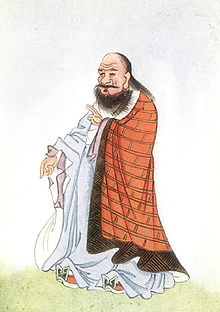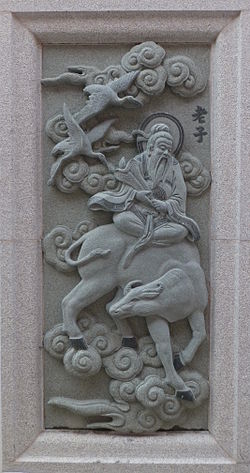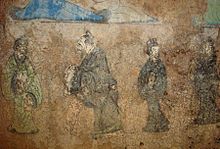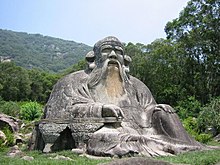Laozi
老子 | |
|---|---|

Laozi by Zhang Lu; Ming dynasty (1368–1644)
| |
| Born | 601 BC
Chujen village, state of Chu
|
| Died | Unknown, departed to the West in 531 BC (aged 70) |
| Era | Ancient philosophy |
| Region | Chinese philosophy |
| School | Taoism |
Notable ideas
| Tao, wu wei |
| Laozi | |||

"Lǎozǐ" in seal script (top) and regular (bottom) Chinese characters
| |||
| Chinese name | |||
|---|---|---|---|
| Chinese | 老子 | ||
| Hanyu Pinyin | Lǎozǐ | ||
| Literal meaning | "Old Master" | ||
| |||
| Vietnamese name | |||
|---|---|---|---|
| Vietnamese | Lão Tử | ||
| Hán-Nôm | 老子 | ||
| Korean name | |||
| Hangul | 노자 | ||
| Hanja | 老子 | ||
| |||
| Japanese name | |||
|---|---|---|---|
| Kanji | 老子 | ||
| Hiragana | ろうし | ||
Laozi (UK: /ˈlaʊˈzɪə/; US: /ˈlaʊˈtsiː/; Chinese: 老子 Mandarin pronunciation: ['làu̯'tsɨ̞]; literally "Old Master"), also rendered as Lao Tzu (/ˈlaʊˈtsuː/ or /ˈlaʊˈdzʌ/) and Lao-Tze (/ˈlaʊˈdzeɪ/), was an ancient Chinese philosopher and writer. He is the reputed author of the Tao Te Ching, the founder of philosophical Taoism, and a deity in religious Taoism and traditional Chinese religions.
A semi-legendary figure, Laozi was usually portrayed as a 6th-century BC contemporary of Confucius, but some modern historians consider him to have lived during the Warring States period of the 4th century BC. A central figure in Chinese culture, Laozi is claimed by both the emperors of the Tang dynasty and modern people of the Li surname as a founder of their lineage. Laozi's work has been embraced by both various anti-authoritarian movements and Chinese Legalism.
Names
In traditional accounts, Laozi's personal name is usually given as Li Er (李耳, Old *rəʔ nəʔ, Mod. Lǐ Ěr) and his courtesy name as Boyang (trad. 伯陽, simp. 伯阳, Old *Pˤrak-lang, Mod. Bóyáng). A prominent posthumous name was Li Dan (李聃, Lǐ Dān).
Laozi itself is a honorific title: 老 (Old *rˤu ʔ, "old, venerable") and 子 (Old *tsəʔ, "master"). It has been romanized numerous ways, sometimes leading to confusion. The most common present form is Laozi or Lǎozǐ, based on the Hanyu Pinyin system adopted by Mainland China in 1958 and by Taiwan in 2009. During the 20th century, Lao-tzu was more common, based on the formerly prevalent Wade–Giles system. In the 19th century, the title was usually romanized as Lao-tse. Other forms include the variants Lao-tze and Lao-tsu.
As a religious figure, he is worshipped under the name "Supreme Old Lord" (太上老君, Tàishàng Lǎojūn) and as one of the "Three Pure Ones." During the Tang dynasty, he was granted the title "Supremely Mysterious and Primordial Emperor" (太上玄元皇帝, Tàishàng Xuānyuán Huángdì).
Historical views
According to Chinese legend, Laozi left China for the west on a water buffalo.
In the mid-twentieth century, a consensus emerged among scholars that the historicity of the person known as Laozi is doubtful and that the Tao Te Ching was "a compilation of Taoist sayings by many hands". Alan Watts
urged more caution, holding that this view was part of an academic
fashion for skepticism about historical spiritual and religious figures
and stating that not enough would be known for years – or possibly ever –
to make a firm judgment.
The earliest certain reference to the present figure of Laozi is found in the 1st‑century BC Records of the Grand Historian collected by the historian Sima Qian from earlier accounts. In one account, Laozi was said to be a contemporary of Confucius during the 6th or 5th century BC. His surname was Li
and his personal name was Er or Dan. He was an official in the imperial
archives and wrote a book in two parts before departing to the west. In
another, Laozi was a different contemporary of Confucius titled Lao Laizi (老莱子) and wrote a book in 15 parts. In a third, he was the court astrologer Lao Dan who lived during the 4th century BC reign of Duke Xian of the Qin Dynasty. The oldest text of the Tao Te Ching so far recovered was written on bamboo slips and dates to the late 4th century BC.
According to traditional accounts, Laozi was a scholar who worked as the Keeper of the Archives for the royal court of Zhou. This reportedly allowed him broad access to the works of the Yellow Emperor
and other classics of the time. The stories assert that Laozi never
opened a formal school but nonetheless attracted a large number of
students and loyal disciples. There are many variations of a story
retelling his encounter with Confucius, most famously in the Zhuangzi.
He was sometimes held to have come from the village of Chu Jen in Chu. In accounts where Laozi married, he was said to have had a son named Zong who became a celebrated soldier.
The story tells of Zong the Warrior who defeats the enemy and
triumphs, and then abandons the corpses of the enemy soldiers to be
eaten by vultures. By coincidence Laozi, traveling and teaching the way
of the Tao, comes on the scene and is revealed to be the father of Zong,
from whom he was separated in childhood. Laozi tells his son that it
is better to treat respectfully a beaten enemy, and that the disrespect
to their dead would cause his foes to seek revenge. Convinced, Zong
orders his soldiers to bury the enemy dead. Funeral mourning is held for
the dead of both parties and a lasting peace is made.
Many clans of the Li family trace their descent to Laozi, including the emperors of the Tang dynasty. This family was known as the Longxi Li lineage (隴西李氏).
According to the Simpkinses, while many (if not all) of these lineages
are questionable, they provide a testament to Laozi's impact on Chinese
culture.
Laozi meets Yinxi
Confucius meets Laozi, Shih Kang, Yuan dynasty
The third story in Sima Qian states that Laozi grew weary of the moral decay of life in Chengzhou
and noted the kingdom's decline. He ventured west to live as a hermit
in the unsettled frontier at the age of 80. At the western gate of the
city (or kingdom), he was recognized by the guard Yinxi.
The sentry asked the old master to record his wisdom for the good of
the country before he would be permitted to pass. The text Laozi wrote
was said to be the Tao Te Ching, although the present version of
the text includes additions from later periods. In some versions of the
tale, the sentry was so touched by the work that he became a disciple
and left with Laozi, never to be seen again. In others, the "Old Master" journeyed all the way to India and was the teacher of Siddartha Gautama, the Buddha. Others say he was the Buddha himself.
Depiction of Laozi in E. T. C. Werner's Myths and Legends of China
A seventh-century work, the Sandong Zhunang ("Pearly Bag of
the Three Caverns"), embellished the relationship between Laozi and
Yinxi. Laozi pretended to be a farmer when reaching the western gate,
but was recognized by Yinxi,
who asked to be taught by the great master. Laozi was not satisfied by
simply being noticed by the guard and demanded an explanation. Yinxi
expressed his deep desire to find the Tao and explained that his
long study of astrology allowed him to recognize Laozi's approach. Yinxi
was accepted by Laozi as a disciple. This is considered an exemplary
interaction between Taoist master and disciple, reflecting the testing a
seeker must undergo before being accepted. A would-be adherent is
expected to prove his determination and talent, clearly expressing his
wishes and showing that he had made progress on his own towards
realizing the Tao.
The Pearly Bag of the Three Caverns continues the parallel of an adherent's quest. Yinxi received his ordination when Laozi transmitted the Tao Te Ching,
along with other texts and precepts, just as Taoist adherents receive a
number of methods, teachings and scriptures at ordination. This is only
an initial ordination and Yinxi still needed an additional period to
perfect his virtue, thus Laozi gave him three years to perfect his Tao.
Yinxi gave himself over to a full-time devotional life. After the
appointed time, Yinxi again demonstrates determination and perfect
trust, sending out a black sheep to market as the agreed sign. He
eventually meets again with Laozi, who announces that Yinxi's immortal
name is listed in the heavens and calls down a heavenly procession to
clothe Yinxi in the garb of immortals. The story continues that Laozi
bestowed a number of titles upon Yinxi and took him on a journey
throughout the universe, even into the nine heavens. After this
fantastic journey, the two sages set out to western lands of the
barbarians. The training period, reuniting and travels represent the
attainment of the highest religious rank in medieval Taoism called
"Preceptor of the Three Caverns". In this legend, Laozi is the perfect
Taoist master and Yinxi is the ideal Taoist student. Laozi is presented
as the Tao personified, giving his teaching to humanity for their
salvation. Yinxi follows the formal sequence of preparation, testing,
training and attainment.
The story of Laozi has taken on strong religious overtones since the Han dynasty. As Taoism took root, Laozi was worshipped as a god. Belief in the revelation of the Tao from the divine Laozi resulted in the formation of the Way of the Celestial Masters,
the first organized religious Taoist sect. In later mature Taoist
tradition, Laozi came to be seen as a personification of the Tao.
He is said to have undergone numerous "transformations" and taken on
various guises in various incarnations throughout history to initiate
the faithful in the Way. Religious Taoism often holds that the "Old
Master" did not disappear after writing the Tao Te Ching but rather spent his life traveling and revealing the Tao.
Taoist myths
state that Laozi was conceived when his mother gazed upon a falling
star. He supposedly remained in her womb for 62 years before being born
while his mother was leaning against a plum tree. (The Chinese surname Li shares its character
with "plum".) Laozi was said to have emerged as a grown man with a full
grey beard and long earlobes, both symbols of wisdom and long life. Other myths state that he was reborn 13 times after his first life during the days of Fuxi. In his last incarnation as Laozi, he lived nine hundred and ninety years and spent his life traveling to reveal the Tao.
Tao Te Ching
Laozi Immortal and Grand Master of Heaven
Laozi is traditionally regarded as the author of the Tao Te Ching (Daodejing), though the identity of its author(s) or compiler(s) has been debated throughout history. It is one of the most significant treatises in Chinese cosmogony. As with most other ancient Chinese philosophers,
Laozi often explains his ideas by way of paradox, analogy,
appropriation of ancient sayings, repetition, symmetry, rhyme, and
rhythm. In fact, the whole book can be read as an analogy – the ruler is
the awareness, or self, in meditation and the myriad creatures or
empire is the experience of the body, senses and desires.
The Tao Te Ching, often called simply Laozi after its reputed author, describes the Dao (or Tao)
as the source and ideal of all existence: it is unseen, but not
transcendent, immensely powerful yet supremely humble, being the root of
all things. People have desires and free will (and thus are able to
alter their own nature). Many act "unnaturally", upsetting the natural
balance of the Tao. The Tao Te Ching intends to lead students to a "return" to their natural state, in harmony with Tao. Language and conventional wisdom are critically assessed. Taoism views them as inherently biased and artificial, widely using paradoxes to sharpen the point.
Livia Kohn provides an example of how Laozi encouraged a change
in approach, or return to "nature", rather than action. Technology may
bring about a false sense of progress. The answer provided by Laozi is
not the rejection of technology, but instead seeking the calm state of wu wei, free from desires. This relates to many statements by Laozi encouraging rulers to keep their people in "ignorance", or "simple-minded". Some scholars insist this explanation ignores the religious context, and others question it as an apologetic
of the philosophical coherence of the text. It would not be unusual
political advice if Laozi literally intended to tell rulers to keep
their people ignorant. However, some terms in the text, such as "valley
spirit" (gushen) and "soul" (po), bear a metaphysical context and cannot be easily reconciled with a purely ethical reading of the work.
Wu wei (無爲), literally "non-action" or "not acting", is a central concept of the Tao Te Ching. The concept of wu wei
is multifaceted, and reflected in the words' multiple meanings, even in
English translation; it can mean "not doing anything", "not forcing",
"not acting" in the theatrical sense, "creating nothingness", "acting
spontaneously", and "flowing with the moment."
It is a concept used to explain ziran (自然), or harmony with the Tao.
It includes the concepts that value distinctions are ideological and
seeing ambition of all sorts as originating from the same source. Laozi
used the term broadly with simplicity and humility
as key virtues, often in contrast to selfish action. On a political
level, it means avoiding such circumstances as war, harsh laws and heavy
taxes. Some Taoists see a connection between wu wei and esoteric practices, such as zuowang "sitting in oblivion" (emptying the mind of bodily awareness and thought) found in the Zhuangzi.
Taoism
Laozi is traditionally regarded as the founder of Taoism, intimately connected with the Tao Te Ching and "primordial" (or "original") Taoism. Popular ("religious") Taoism typically presents the Jade Emperor as the official head deity. Intellectual ("elite") Taoists, such as the Celestial Masters sect, usually present Laozi (Laojun, "Lord Lao") and the Three Pure Ones at the top of the pantheon of deities.
Influence
A Western Han (202 BC – 9 AD) fresco depicting Confucius and Laozi, from a tomb of Dongping County, Shandong province, China
A stone sculpture of Laozi, located north of Quanzhou at the foot of Mount Qingyuan
Potential officials throughout Chinese history drew on the authority of non-Confucian sages, especially Laozi and Zhuangzi,
to deny serving any ruler at any time. Zhuangzi, Laozi's most famous
follower in traditional accounts, had a great deal of influence on
Chinese literati and culture.
Political
theorists influenced by Laozi have advocated humility in leadership and
a restrained approach to statecraft, either for ethical and pacifist
reasons, or for tactical ends. In a different context, various
anti-authoritarian movements have embraced the Laozi teachings on the
power of the weak.
Laozi was a proponent of limited government. Left-libertarians in particular have been influenced by Laozi – in his 1937 book Nationalism and Culture, the anarcho-syndicalist writer and activist Rudolf Rocker
praised Laozi's "gentle wisdom" and understanding of the opposition
between political power and the cultural activities of the people and
community. In his 1910 article for the Encyclopædia Britannica, Peter Kropotkin also noted that Laozi was among the earliest proponents of essentially anarchist concepts. More recently, anarchists such as John P. Clark and Ursula K. Le Guin
have written about the conjunction between anarchism and Taoism in
various ways, highlighting the teachings of Laozi in particular.
In her rendition of the Tao Te Ching, Le Guin writes that Laozi "does
not see political power as magic. He sees rightful power as earned and
wrongful power as usurped... He sees sacrifice of self or others as a
corruption of power, and power as available to anyone who follows the
Way. No wonder anarchists and Taoists make good friends."
The right-libertarian economist Murray Rothbard suggested that Laozi was the first libertarian, likening Laozi's ideas on government to Friedrich Hayek's theory of spontaneous order.
James A. Dorn agreed, writing that Laozi, like many 18th-century
liberals, "argued that minimizing the role of government and letting
individuals develop spontaneously would best achieve social and economic
harmony." Similarly, the Cato Institute's David Boaz includes passages from the Tao Te Ching' in his 1997 book The Libertarian Reader. Philosopher Roderick Long, however, argues that libertarian themes in Taoist thought are actually borrowed from earlier Confucian writers.







